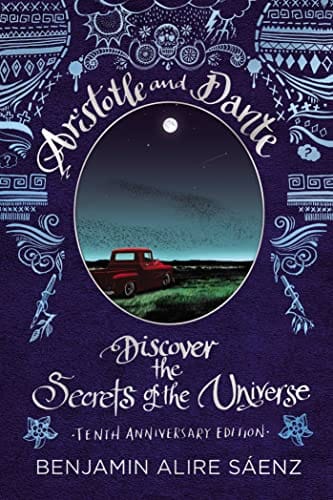Aristotle and Dante Discover the Secrets of the Universe: A Comprehensive Review
This lyrical YA novel follows two Mexican-American teens whose friendship blossoms into love, offering a heartfelt exploration of identity, family, and self-acceptance.

Introduction
Since its publication in 2012, Benjamin Alire Sáenz’s award-winning novel Aristotle and Dante Discover the Secrets of the Universe has enchanted readers with its poetic prose, vivid desert landscapes, and emotionally resonant coming-of-age story. Blending family drama, cultural identity, and LGBTQ+ discovery, the book follows two Mexican-American teens in 1980s El Paso whose unlikely friendship blooms into life-altering love. This 800-word review explores the novel’s plot, characters, themes, and cultural impact while explaining why it continues to magnetize young adult and adult audiences alike.
Plot Overview
The story opens during a sweltering summer break when introverted Aristotle “Ari” Mendoza, a boy burdened by anger and unanswered questions, meets bubbly, intellectual Dante Quintana at a neighborhood pool. Dante patiently teaches Ari how to swim, and the pair sets off on long desert walks, comic-book exchanges, and philosophical debates. Yet their idyllic days are punctured by real-world dangers: a near-drowning, a shocking car accident, and homophobic violence. As seasons change, Ari wrestles with his family’s silence about his imprisoned brother, while Dante grapples with the courage to declare his sexuality. Gradually, the boys uncover not only the secrets of the universe but also the truths inside their own hearts.
Character Study: Ari and Dante
Sáenz crafts two protagonists who feel remarkably authentic. Ari’s voice, simultaneously sardonic and tender, captures the messy contradictions of teenage masculinity. His interior monologue brims with suppressed vulnerability as he navigates anger toward an emotionally distant father and guilt over his brother’s incarceration. Dante, by contrast, radiates openness; he wears vulnerability proudly and cries without shame. Their contrasting personalities create a dynamic tension that propels the narrative. Secondary characters—especially Ari’s war-scarred father, his fiercely protective mother, and Dante’s bookish parents—enrich the story, providing compassionate models of Latino parenting rarely depicted with such nuance in young adult literature.
Major Themes
Identity formation sits at the novel’s core. Ari struggles with Mexican-American heritage, masculinity, and sexuality, fearing labels that might confine him. Sáenz illustrates how silence—whether familial or societal—can stall self-discovery. Another central theme is the transformative power of friendship. Through Dante’s unwavering affection, Ari confronts buried emotions and learns that vulnerability can be strength. The narrative also interrogates generational trauma: both families carry scars from war, imprisonment, and discrimination, showing how past wounds ripple through the present. Finally, the desert setting operates almost as a character itself, symbolizing both isolation and vast possibility.
Poetic Writing Style
Sáenz’s prose is deceptively simple yet deeply lyrical. Short sentences mimic Ari’s clipped inner voice, while sparse dialogue conveys unspoken tension. The author’s background as a poet shines in imagery like “the sky was so blue it looked as if God had opened his eyes.” Repetition—“And there would be rain. And there would be pain.”—imbues scenes with rhythmic urgency. This musicality invites readers to linger on each line, heightening emotional payoff without sacrificing accessibility. Because the language is clear and reflective, the book resonates with reluctant readers and literary aficionados alike, a rare achievement in contemporary YA fiction.
Representation and Cultural Impact
Long before mainstream publishers sought diverse casts, Aristotle and Dante provided a heartfelt portrayal of queer, brown, working-class teens. Sáenz refuses stereotypes: both families are loving, functional, and proudly bilingual, challenging tropes of Latino dysfunction. The novel’s success—the Stonewall Book Award, the Pura Belpré, and the Michael L. Printz Honor—signaled a hunger for intersectional stories within the YA market. Educators now teach the book to spark discussions on identity, sexuality, and cultural pride, while countless readers cite Ari and Dante as mirrors that validated their own experiences. Its influence can be traced in the surge of Latinx LGBTQ+ titles that followed.
Who Should Read This Book?
Though marketed to teens, the novel’s introspective tone and universal themes speak to adults reminiscing about first love, family conflict, and self-acceptance. Fans of John Green, Angie Thomas, or Adam Silvera will appreciate its character-driven narrative, yet its philosophical musings may also attract readers of literary fiction. Book clubs will find ample material for discussion, from the symbolism of the desert rain to the ethics of silence. Additionally, parents and educators seeking authentic representation of Mexican-American life and LGBTQ+ identity will discover a sensitive, hopeful resource.
Conclusion
Aristotle and Dante Discover the Secrets of the Universe endures because it refuses to simplify adolescence into neat binaries. Love coexists with fear, anger with tenderness, silence with revelation. By the novel’s end, Ari’s whispered confession—“Dante, I’m in love with you”—feels monumental not only for the characters but for every reader who has struggled to voice truth. Sáenz reminds us that the universe’s greatest secret may be disarmingly simple: we are made to know and be known. In a literary landscape that often chases trends, this quiet, luminous story remains timeless.



